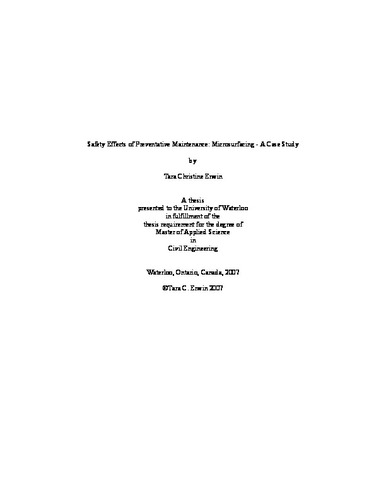| dc.contributor.author | Erwin, Tara Christine | |
| dc.date.accessioned | 2007-09-19 22:04:52 (GMT) | |
| dc.date.available | 2007-09-19 22:04:52 (GMT) | |
| dc.date.issued | 2007-09-19T22:04:52Z | |
| dc.date.submitted | 2007 | |
| dc.identifier.uri | http://hdl.handle.net/10012/3257 | |
| dc.description.abstract | Various North American transportation agencies have implemented several preventative maintenance techniques to improve pavement performance and safety. The Region of York, located north east of Toronto, Ontario, has been resurfacing and remedying pavements with microsurfacing treatments to improve the pavement surface conditions. Often times these maintenance methods were selected because they seemed the most appropriate given a budget constraint however little was known if these treatments impacted road safety. The Region of York made their road and safety data accessible for the purpose of this research. Thus the focus of this thesis is to gain an understanding of how microsurfacing and resurfacing treatments impact road safety to help the Region of York and potentially other jurisdictions make more sound decisions when selecting pavement maintenance treatments. Road related fatalities account for 90 percent of transportation related deaths in Canada despite safety measures such as stronger safety laws and public awareness campaigns. There is a need for engineers to think outside of the box and look at other ways to improve road safety. Given the high costs to society for crashes it only seems logical that safety should be a part of a preventative maintenance decision making process. A fair amount of research has been done on the influence of pavement friction on traffic safety; however no studies were uncovered that examined how microsurfacing (a treatment designed to improve the frictional properties of pavement) affected safety. This study accomplishes five research objectives based on the needs of the Region of York and past experience: 1. Establishes that there is a statistically significant relationship between microsurfacing treatments and safety for specific traffic conditions using a before-after analysis 2. Determines that there is a statistically significant relationship between resurfacing and safety under specific traffic conditions using a before-after analysis 3. Illustrates the need and value added if there is better cohesion between road data and safety data 4. Demonstrate that safety has a role to play in pavement management, especially regarding preventative maintenance strategies and offers guidance on how to approach the integration using York Region as a case study 5. Develops a concept decision making framework that demonstrates how safety data should be considered in pavement maintenance decision making at both the network level applying life cycle costs and project level using decision making flowcharts. These tools while specific to York Region can be adopted in jurisdictions with similar characteristics The study concludes that microsurfacing and resurfacing safety effects are sensitive to the influence of treatment year data (which may be an anomaly period) and average annual daily traffic (AADT) per lane. The findings of this study have opened the door to additional research; integration of safety under the pavement umbrella seems logical and yet has barely been explored. Recommendations that have resulted from this work deal with data collected and how it is managed; analysis methodology and additional opportunities for further study; and finally how to optimize the application of the findings to best serve engineers that are involved in the maintenance decision making process. There is much potential for further research in the area of safety within a pavement management framework and the resultant studies will have a tremendous benefit to society. | en |
| dc.language.iso | en | en |
| dc.publisher | University of Waterloo | en |
| dc.subject | safety | en |
| dc.subject | microsurfacing | en |
| dc.title | Safety Effects of Preventative Maintenace: Microsurfacing : A Case Study | en |
| dc.type | Master Thesis | en |
| dc.pending | false | en |
| dc.subject.program | Civil Engineering | en |
| uws-etd.degree.department | Civil and Environmental Engineering | en |
| uws-etd.degree | Master of Applied Science | en |
| uws.typeOfResource | Text | en |
| uws.peerReviewStatus | Unreviewed | en |
| uws.scholarLevel | Graduate | en |

